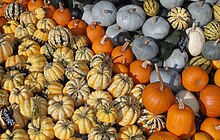Squash (vegetable)
| Squash | |
|---|---|
 |
|
| Cucurbita fruits come in an assortment of colors and sizes. | |
| Scientific classification | |
| Kingdom: | Plantae |
| Clade: | Angiosperms |
| Clade: | Eudicots |
| Clade: | Rosids |
| Order: | Cucurbitales |
| Family: | Cucurbitaceae |
| Tribe: | Cucurbiteae |
| Genus: |
Cucurbita L. |
| Synonyms | |
| Nutritional value per 100 g (3.5 oz) | |
|---|---|
| Energy | 69 kJ (16 kcal) |
|
3.4 g
|
|
| Sugars | 2.2 g |
| Dietary fiber | 1.1 g |
|
0.2 g
|
|
|
1.2 g
|
|
| Vitamins | |
| Vitamin A equiv. |
(1%)
10 μg
(1%)
120 μg2125 μg
|
| Thiamine (B1) |
(4%)
0.048 mg |
| Riboflavin (B2) |
(12%)
0.142 mg |
| Niacin (B3) |
(3%)
0.487 mg |
| Pantothenic acid (B5) |
(3%)
0.155 mg |
| Vitamin B6 |
(17%)
0.218 mg |
| Folate (B9) |
(7%)
29 μg |
| Vitamin C |
(20%)
17 mg |
| Vitamin K |
(3%)
3 μg |
| Minerals | |
| Iron |
(3%)
0.35 mg |
| Magnesium |
(5%)
17 mg |
| Manganese |
(8%)
0.175 mg |
| Phosphorus |
(5%)
38 mg |
| Potassium |
(6%)
262 mg |
| Zinc |
(3%)
0.29 mg |
| Other constituents | |
| Water | 95 g |
|
Link to USDA Database entry, for comparison, see values for raw pumpkin
|
|
|
|
| Percentages are roughly approximated using US recommendations for adults. Source: USDA Nutrient Database |
|
Cucurbita (Latin for gourd) is a genus of herbaceous vines in the gourd family, Cucurbitaceae, also known as cucurbits, native to the Andes and Mesoamerica. Five species are grown worldwide for their edible fruit, variously known as squash, pumpkin, or gourd depending on species, variety, and local parlance, and for their seeds. Other kinds of gourd, also called bottle-gourds, are native to Africa and belong to the genus Lagenaria, which is in the same family and subfamily as Cucurbita but in a different tribe. These other gourds are used as utensils or vessels, and their young fruits are eaten much like those of Cucurbita species.
Most Cucurbita species are herbaceous vines that grow several meters in length and have tendrils, but non-vining "bush" cultivars of C. pepo and C. maxima have also been developed. The yellow or orange flowers on a Cucurbita plant are of two types: female and male. The female flowers produce the fruit and the male flowers produce pollen. Many North and Central American species are visited by specialist bee pollinators, but other insects with more general feeding habits, such as honey bees, also visit.
There is debate about the taxonomy of the genus, as the number of accepted species varies from 13 to 30. The five domesticated species are Cucurbita argyrosperma, C. ficifolia, C. maxima, C. moschata, and C. pepo. All of these can be treated as winter squash because the full-grown fruits can be stored for months; however, C. pepo includes some cultivars that are better used only as summer squash.
...
Wikipedia
